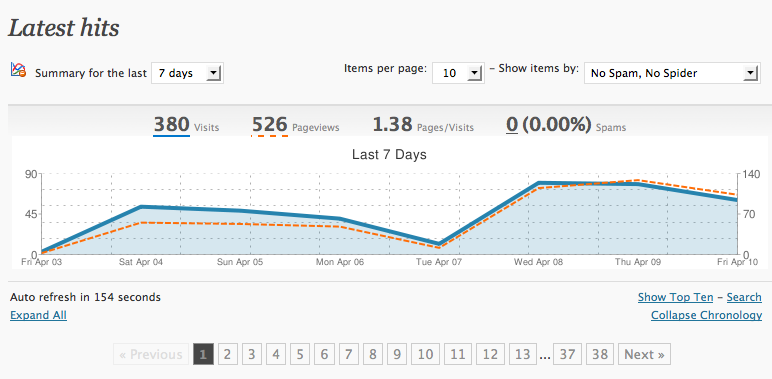I’m often asked for advice and help from both experienced and new WordPress users and the questions mostly involve themes and plugins. In this post I’ll give my top 12 plugin picks. My favorite plugins are always changing as I learn of new ones and find that I cannot live without them. Plugin needs also vary depending on the project.
Plugin Central
To me this is the one essential plugin that every WordPress installation MUST have. In fact, it should be your very first plugin and the only one you need to install via FTP. Why? Once you install this plugin, you never need to use FTP again to install plugins. I realize that WordPress 2.7 has some functionality to automatically download plugins, but it doesn’t compare to Plugin Central. Plugin Central is very simple and straightforward. You simply enter the name of the plugin you wish to install and that’s it. Plugin Central does all of the heavy lifting by downloading and installing the plugin for you. You do need to get the name right and you also need to go to the main plugin page once the plugin is downloaded and be sure to ACTIVATE it.

You can enter as many plugins as you want in the form and all will be downloaded and installed at the same time. One great feature is the ability to list all plugins (or active plugins) in your WordPress installation. By doing this on existing installations, you can simply copy and paste the names into a new installation to get all of your favorite plugins downloaded and installed at one time.
WP-DBManager
When I first discovered this plugin I was amazed it was free. If you don’t already have it RACE to download and install it immediately. WP-DBManager essentially does what the name implies — it manages all aspects of your WordPress MySQL database. The plugin allows you to optimize, repair and drop tables, backup the database to a directory and best of all, send you a backup copy on a scheduled basis. The backup can be compressed at your option.

All in One SEO Pack & Headspace2 (tie)
I use both of these plugins on my various projects and don’t really favor one over the other. They are both terrific and you should definitely use one of them. Both give you full control over your meta tags and page titles. You can specify specific tags and titles on a post-by-post basis or specify defaults such as using the post title for the page title, the beginning of the post for the description, the tags and categories for the meta keywords, etc., etc.
Google XML Sitemaps
This plugin will automatically generate an XML sitemap page for your WordPress blog and submit it to Google and other major search engines. The plugin gives you tons of flexibility to specify frequency of updates and submissions, how you weight the various pieces of content on your site which pages you want to include/exclude, etc., etc.
Redirection
This plugin gives you full control over redirection. The plugin is particularly useful if you are changing your site from a different directory or naming convention and want to automatically redirect old page names to new page names. The plugin will also monitor 404 errors and keep full logs of all redirections.
WP Super Cache
WP Super Cache will really help to speed up your site by caching your pages and makes a big difference on sites with heavy traffic. It can be a god-send if a post on your site gets picked up in digg or stumbleupon and you find yourself with a big spike in traffic (hey, guys and girls, feel free to digg this article and see how well the plugin works!).
WP Hive
This is a really cool plugin that is a bit more specialized than the other plugins mentioned in the round-up. Rather than supply a specific functionality to any WordPress blog, WP Hive allows you to run multiple WordPress blogs using the same set of files, plugins and themes. I don’t use this all the time, but do have it running on a few hosts where I have a bunch of blogs sharing the same files. It requires a bit of tweaking and has a few peculiarities that you’ll need to work-around until John gets to updating it, but it does work very well and I strongly suggest you give it a try if you have many blogs and do not like to keep separate FTP logins and maintain multiple sets of files. I will note that by using Plugin Central to easily install and update your plugins and given the fact that WordPress 2.7 does come with an auto-update feature, the need for WP Hive is not as great as it once was.
Cross-linker
Great plugin to add cross-linking between your posts, pages and other websites. Cross-linking is an essential element for effective SEO and the Cross-linker plugin does much of the heavy-lifting. The plugin allows you to specify words and phrases and associate a URL/hyperlink with them. When the plugin finds these words and phrases it adds the links. You have control over how many times in a page the links will be added and you can also exclude the links when the words/phrases come inside of certain tags. For example, you might want to cross-link the phrase “Ford Explorer” to a page on your site that deals with the SUV, but you don’t want the hyperlink to be added inside the heading tag.
My Category Order
This is a simple plugin that allows you to change the order that your categories appear in the sidebar of your blog. It uses a nifty AJAX drag-and-drop interface. Another great and more interesting use of the plugin comes into play when your theme uses categories to build the top navigation of your site. In most circumstances, depending on the function that the theme uses to write the categories, My Category Order will allow you to set the order that these menu items appear.
WassUp
Wassup is a real-time visitor tracking and statistical tool for WordPress. It isn’t nearly as sophisticated as Google Analytics and other full-featured tools, but in some circumstances you may not choose to use Google Analytics for your tracking. In these cases WassUp will give you most of the information you need to know about your blog’s traffic, how your visitors found your site, how long they stayed, what pages they visited, etc.

Zemanta
Zemanta is a full set of utilities to enhance your blog posts. The plugin will suggest tags, links and photos related to your post content. What’s really great about this plugin is the way it works with photos. It will find a series of photos which it believes match your content and display them in a photo gallery view. When you mouse-over the selected image, Zemanta will describe the photo and identify what type of license it believes the image qualifies for such as fair use or CreativeCommons (e.g., you can use it if you credit the owner and include a link).

Once you are comfortable with using the image, you simply click it and Zemanta will automatically include all of the necessary HTML code in your post. In most cases it will include a credit and link to the image source under the image — see below:

WP-o-Matic
This is a really cool plugin which gives you the ability to read RSS feeds into posts. It uses the paradigm of ‘campaigns’ to set all of your options related to which RSS feeds you wish to read, what categories to assign the posts made from these feeds and how you might want to alter the feed content using custom templates. You decide which elements of the feed to read and what content to add to the beginning or end of each post. WP-o-Matic will check each day for new content in the specified RSS feeds and automatically create new posts for your blog. Of course, there are some issues related to copying posts from other sites and creating your own posts, so you’ll need to decide if your particular use of the feed meets the ‘smell-test.’ It’s often best to check with the feed owner and get their permission or at the minimum, give the feed owner credit and link back to their complete post.


